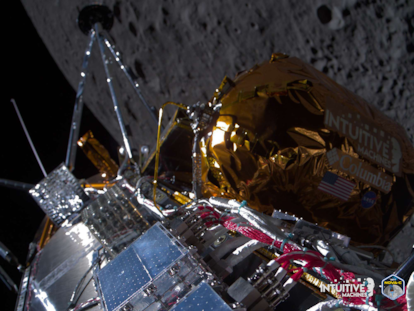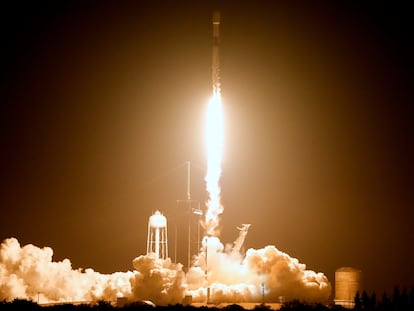The US returns to the moon half a century after the Apollo program
Intuitive Machines’ ‘Odysseus’ device becomes the first from a private company to successfully complete a lunar landing


The United States has returned to the moon. More than half a century after the last mission of the Apollo program, a lander bearing the Stars and Stripes reached the Earth’s natural satellite on Thursday. It has done so thanks to Intuitive Machines, the first private company to achieve the milestone of successfully landing on the moon. The company’s command center is in Houston (Texas), the city where Apollo 17, the last U.S. spacecraft to reach the moon, landed in 1972. Odysseus landed on the surface of the satellite with some delay with respect to the schedule initially planned by NASA, due to some technical problems. Even so, with the suspense of the occasion, it arrived on time for its date with history. Bill Nelson, NASA administrator, had the opportunity to repeat the most famous phrase of the space conquest: “This feat is a great leap forward for all of humanity,” he said.
After the moon landing countdown reached zero, there were a few minutes of uncertainty until communication was restored and confirmation was received that Odysseus had landed on the moon. “I know this was a nail-biter but we are on the surface and we are transmitting,” said Stephen Altemus, president and CEO of Intuitive Machines. In the command room there was anxiety and nervousness, according to the livestream transmitted by NASA and the company, but applause broke out when victory was declared.
There has been no immediate confirmation that everything is working as planned, but NASA also celebrated the moon landing. “Today for the first time in more than a half century, the U.S. has returned to the moon. Today for the first time in the history of humanity, a commercial company, an American company launched and led the voyage up there. And today is a day that shows the power and promise of NASA’s Commercial partnerships. Congratulations to everyone involved in this great and daring quest at Intuitive Machines, SpaceX and right here at NASA,” said Nelson. “What a triumph. Odysseus has taken the moon.”
The milestone comes on the heels of the recent fiasco of a Japanese and a U.S. mission, the latest chapters in a complicated few months in the space race. The Intuitive Machines lunar lander was launched into space by a rocket from SpaceX, the company founded and led by Elon Musk. SpaceX’s Falcon 9 was powered for the first time by methane, a fuel that China had previously successfully used.
The craft, a hexagonal prism with six landing legs more than four meters tall and 1.5 meters wide, came to rest on a plain outside the crater Malapert A. The lander fired its engine on the back side of the moon Wednesday while out of contact with Earth. Flight controllers at the company’s Houston headquarters had to wait for the spacecraft to emerge to find out if the lander was in orbit or drifting aimlessly away — one of the tensest moments of the mission.
All day Thursday, controllers were lowering the craft’s orbit from about 60 miles (92 kilometers) to 6 miles (10 kilometers) in a crucial maneuver on the opposite face of the moon. Then, they targeted the descent near the moon’s south pole. A little more than a mile from the landing site, the spacecraft pivoted into a vertical position and the sensors searched for a safe place to land. The original laser instrument that was to have served as a guide for the landing failed, so another one provided by NASA that was traveling as an experimental payload was used in its place. This meant the lander had to orbit the moon once again, delaying the lunar landing by two hours.
In the last 15 meters of the descent, the lander stopped using the camera and the altitude measurement laser so as not to be fooled by the dust raised by the engine exhaust.
Odysseus landed in a dangerous region for a lunar landing, as it is full of craters and cliffs. This area is being used because these permanently shadowed craters are believed to contain frozen water, near the Malapert A crater, 161 miles (260 kilometers) from the moon’s south pole. The crater is named after the 17th century Belgian astronomer Charles Malapert. There, close to where India has successfully landed, the hope is that the gigantic water ice resource will be able to be exploited for future space exploration. Astronauts visiting the Moon in the future could use the ice in these craters for drinking water, oxygen and even fuel. Previous U.S. missions have reached the equatorial lunar regions.
Private collaboration
NASA has moved to subcontracting private companies for many of its missions, and plans to continue to do so. Intuitive Machines is one of 14 vendors selected to carry payloads to the moon through NASA’s CLPS (Commercial Lunar Payload Services) initiative. Through this program, NASA is looking for U.S. companies to carry science, exploration and technology payloads to the moon’s surface and orbit.
In this mission, NASA is the main customer, it has half of the 12 payloads carried by Odysseus. The U.S. space agency paid Intuitive Machines $118 million to carry these instruments to the moon. These include a stereo camera to observe the dust plume that rises during landing; a radio receiver to measure the effects of charged particles on radio signals; an experiment with autonomous navigation functionality to support future surface and orbital operations; a set of eight retroreflectors that will serve as a permanent position marker on the moon for decades; a Lidar-based descent and landing sensor, an instrument that works on the same principles as radar, but with lasers (which had to be used in descent); and a meter that uses radio waves to determine how much propellant fuel remains in tanks in a low-gravity environment.
There are also payloads from other clients, such as a camera built by students at Embry-Riddle Aeronautical University in Daytona Beach, Florida, and an art project by Jeff Koons.
Intuitive Machines has made history by becoming the first private company to successfully reach the moon. Three previous non-governmental attempts failed. The U.S.-based Astrobotic Technology attempted to send a module last month, but it did not even reach the moon due to a loss of fuel. This craft returned in free fall through the atmosphere and burned up and disintegrated over the Pacific. All the equipment on board, from various institutions around the world, was lost with the spacecraft. Japan’s Hakuto-R probe, which made an attempt in April last year, gave no signal after the scheduled contact time, which was interpreted as a crash. A similar attempt launched by an Israeli group crashed in 2019.
Japan in January became the fifth nation to successfully land on the moon, but its spacecraft did so sideways. The Japanese SLIM probe landed with the thrusters facing up and the solar panels turned sideways, so its functions were severely compromised. The other four countries that — thanks to government initiatives — have reached the moon are the U.S., the former Soviet Union, China and India.
With missions like the current one, NASA aims to gain new knowledge about the lunar environment to support future manned missions as part of its Artemis campaign. This mission was IM-1. Intuitive Machines intends to launch the IM-2 mission later this year and IM-3 in 2025. For now, NASA has had to postpone its plans to return with a crewed mission to the moon, precisely due to the technical problems with several of the companies involved. The last time astronauts set foot on the moon was in December 1972, with Apollo 17. Half a century after Gene Cernan and Harrison Schmidt’s moonwalk, the space adventure continues.
Sign up for our weekly newsletter to get more English-language news coverage from EL PAÍS USA Edition
Tu suscripción se está usando en otro dispositivo
¿Quieres añadir otro usuario a tu suscripción?
Si continúas leyendo en este dispositivo, no se podrá leer en el otro.
FlechaTu suscripción se está usando en otro dispositivo y solo puedes acceder a EL PAÍS desde un dispositivo a la vez.
Si quieres compartir tu cuenta, cambia tu suscripción a la modalidad Premium, así podrás añadir otro usuario. Cada uno accederá con su propia cuenta de email, lo que os permitirá personalizar vuestra experiencia en EL PAÍS.
¿Tienes una suscripción de empresa? Accede aquí para contratar más cuentas.
En el caso de no saber quién está usando tu cuenta, te recomendamos cambiar tu contraseña aquí.
Si decides continuar compartiendo tu cuenta, este mensaje se mostrará en tu dispositivo y en el de la otra persona que está usando tu cuenta de forma indefinida, afectando a tu experiencia de lectura. Puedes consultar aquí los términos y condiciones de la suscripción digital.
More information
Archived In
Últimas noticias
Not all insomnia is the same: Study identifies five subtypes and paves the way for personalized treatment
The United States designates Clan de Golfo as a foreign terrorist group
The United States strikes three more suspected drug boats, killing eight
The Iberian Peninsula is rotating clockwise, scientists report
Most viewed
- ‘El Limones’ and the growing union disguise of Mexican organized crime
- Christian Louboutin: ‘Young people don’t want to be like their parents. And if their parents wear sneakers, they’re going to look for something else’
- ‘We are dying’: Cuba sinks into a health crisis amid medicine shortages and misdiagnosis
- A mountaineer, accused of manslaughter for the death of his partner during a climb: He silenced his phone and refused a helicopter rescue
- Liset Menéndez de la Prida, neuroscientist: ‘It’s not normal to constantly seek pleasure; it’s important to be bored, to be calm’










































